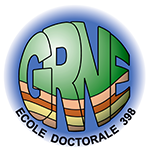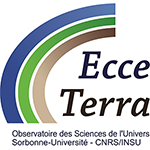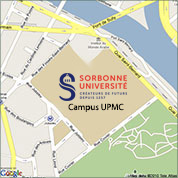Séminaire ISTeP - Samuel Angiboust

(ENS-Lyon)
Fluid Flow and Mantle Wedge Deformation: the Dangerous Liaisons
An increasing number of seismological studies report transient seismicity clusters in the mantle wedge several kilometers above the subduction interface. Their physical significance with respect to subduction zone seismo-tectonics remains poorly understood. Jadeitites are known to form and/or be associated with mantle wedge serpentinites in the c. 30–70 km depth range, and thus may yield information on deformation mechanisms in this region of deep subduction environments. We herein document and compare brittle-viscous features recorded in jadeitites from Polar Urals (Russia), Kashin state (Myanmar) and Motagua fault region (Guatemala) – some of the most important jadeitite occurrences worldwide. In the Polar Urals we identified ultramafic-hosted pristine jadeitite-bearing veins c. 1 km above a Devonian paleo-subduction interface, interpreted as metasomatized former felsic dyke networks crosscutting the mantle wedge peridotites. Here, both jadeitites and associated amphibole-rich dark granofels display widespread brittle-ductile deformation fabrics such as shear bands, foliated cataclasites and breccias, cemented through dissolution-precipitation processes by omphacite and sodic amphiboles, a mineral assemblage typical of high-pressure–low-temperature subduction zone conditions. Electron probe and laser ablation ICP-MS mapping indicate that these brittle-viscous networks display a substantial metasomatic imprint highlighted in the dark granofels by variations in major and trace elements. Switches between viscous and brittle deformation patterns are attested by crystallographic-preferred orientations of jadeite in some of the shear zones that crosscut the host jadeitites. Strikingly similar mineral assemblages and deformation patterns were observed in the Kashin and Motagua samples. Observed deformation features in these localities can be classified into three categories (tectonic breccias, foliated cataclasites and hydraulic breccias), which may occasionally form in sequence and exhibit mutually overprinting textures. Some of the foliated cataclasites contain fine-grained and foliated “shard-like” features forming a radial omphacite-jadeite spherulitic texture, interpreted as former pseudotachylyte that evokes a paleo-seismic origin. We interpret these healed fault networks as recording external fluid influx within fracture zones that repeatedly ruptured along former “dyke” networks. These high permeability drains likely (i) contribute to the transfer of highly pressurized plate-interface metamorphic fluids into the mantle wedge; and (ii) trigger seismic instabilities recorded in the basal part of active mantle wedge sections. These findings provide new insights into the current understanding of the rheology (e.g., serpentinization ratio) and stress state in the mantle wedge, with implications for subduction interface seismogenesis.
vendredi 8 octobre à 12h30
https://zoom.us/j/91818869487?pwd=SE5YQVdSVGRqVkVMTmIzaFlWcHhHZz09
Meeting ID: 918 1886 9487
Passcode: 76mBkM
Egalement dans la rubrique
- Séminaire ISTeP - Carole Berthod
- Séminaire ISTeP - Razvan Poppa
- Webinaire ISTeP - Yann Klinger
- Webinaire ISTeP - Sylvain Garel
- Webinaire ISTeP - Vincent Roche
- Webinaire ISTeP - Cécile Arenes
- Webinaire ISTeP - Jorge Jara
- Séminaire ISTeP - Sarah Incel
- Séminaire ISTeP - Romain Rubi
- Séminaire ISTeP - Jean-Paul Callot
- Séminaire ISTeP - Sabine Den Hartog
- Séminaire ISTeP - Thibault Cavailhes
Chiffres clés
L'ISTeP comprend 108 membres dont :
- 12 professeurs
- 21 maîtres de conférences
- 2 directeurs de recherche CNRS
- 2 chargés de recherche CNRS
- 7 ATER et post-docs
- 26 doctorants
- 21 ITA-IATSS
- 17 collaborateurs bénévoles / émérites





